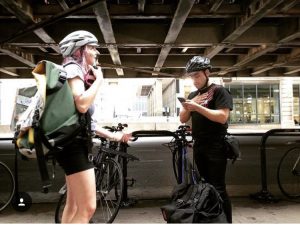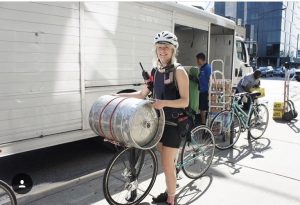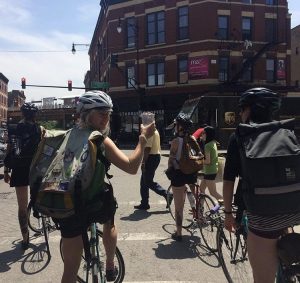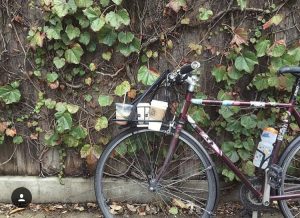By: Joanna McCall
In this blog, I will explain some fascinating aspects of individuals that work on their bikes. We have all seen them; maybe a Jimmy John’s employee has cut you off recently, maybe you have noticed the same person trekking downtown from your neighborhood with a sling bag and a radio every day, or maybe you have fond (or not so fond) memories of delivering local newspapers in high school. Whatever your relationship has been thus far, we are about to take a small dive into this world.
 Let us start with messengers. These hard-working employees often work for downtown companies, making trips in and out of messenger centers all day, mainly on their bicycles. Notably, some of the “classic” forms of messengering—e.g., delivering paper documents – have shrunk due to the major advances in communicative technologies. Still, in large cities, many streets remain abuzz with bike messengers working weekdays 9-5. Short trips around downtown dominate this sector, but most companies also have “longboard riders” who travel greater distances and occasionally use vans as well. In Chicago, two of the most prominent messenger companies are 4 Star and US Messenger. If you want to take a deeper dive into some of the history here, look into Chicago’s own Joey Love and the X-Men from New York City. Pioneers in messengering undoubtedly deserve attention.
Let us start with messengers. These hard-working employees often work for downtown companies, making trips in and out of messenger centers all day, mainly on their bicycles. Notably, some of the “classic” forms of messengering—e.g., delivering paper documents – have shrunk due to the major advances in communicative technologies. Still, in large cities, many streets remain abuzz with bike messengers working weekdays 9-5. Short trips around downtown dominate this sector, but most companies also have “longboard riders” who travel greater distances and occasionally use vans as well. In Chicago, two of the most prominent messenger companies are 4 Star and US Messenger. If you want to take a deeper dive into some of the history here, look into Chicago’s own Joey Love and the X-Men from New York City. Pioneers in messengering undoubtedly deserve attention.
As the number of jobs in this more traditional mode declined, more courier work began to emerge. This work primarily consists of food delivery and various other cargo work. This strong emergence can be attributed to many circumstances, and it evolved into a model creating a substantial number of bicycle jobs in our cities. A notable presence here in Chicago at the beginning of this shift was Uptop. I currently work for Cut Cats Courier Collective, one pioneer of the courier “collective model”, which provides all workers enhanced responsibility to the company and to each other. This model allows the groups to contract clients they choose, either self-dispatch or be dispatched by another collective member, mediate the rates and conduct all matters of business within the company. Messenger and courier work can notoriously be dictated by some basement dispatcher and sustained by small checks, and this model works to break this mold in terms of jobs quality.
 This collective approach is also being used in other cities. You can see Send It Courier in Toronto, Confluence Courier in Denver and Brick Road Courier in Orlando as a sample. Rain, shine or snow, these companies operate every day of the year. Only once in my four years as a courier have I been sent home early due to weather conditions: the Super Bowl blizzard three years ago. The only person capable of completing any deliveries that night had a cargo bike with a trash can full of chains on the front and his bike weighed just enough not to slide around.
This collective approach is also being used in other cities. You can see Send It Courier in Toronto, Confluence Courier in Denver and Brick Road Courier in Orlando as a sample. Rain, shine or snow, these companies operate every day of the year. Only once in my four years as a courier have I been sent home early due to weather conditions: the Super Bowl blizzard three years ago. The only person capable of completing any deliveries that night had a cargo bike with a trash can full of chains on the front and his bike weighed just enough not to slide around.
Outside of this contracted model, you also have bicycle work in house for various restaurants. In some smaller cities, this is the primary source of employment on a bicycle. Restaurants such as Jimmy Johns and Potbelly come to mind. I worked at Jimmy Johns about five years ago. Their slogan, “freaky fast” is no hyperbole. I recall the fast paced environment in which a sandwich was required to be delivered within ten minutes of an order being placed. I also found many transient high school and college students came and went, eager to make a few bucks.
 But one of the biggest stories of late is the surge in app-based bicycle workers employed by the likes of Ubereats, Grubhub, Postmates and Amazon. Cyclists working for these companies operate much the same way that Uber or Lyft drivers do; deciding their own hours at their convenience. This model of bicycle delivery varies in a few areas. First, the technology eliminates the role of the dispatcher. Secondly, the riders do not have a singular restaurant providing deliveries such as Jimmy Johns, or familiarity with contracted clients and their packaging. Finally, they have no structure allowing the deliverer to build “sets” and make money off of, say, four deliveries at a time. I suspect and hope that the efficiencies in these “gig economy” deliveries will grow as new strategies unfold, however they are no longer new and these models do not prioritize the worker.
But one of the biggest stories of late is the surge in app-based bicycle workers employed by the likes of Ubereats, Grubhub, Postmates and Amazon. Cyclists working for these companies operate much the same way that Uber or Lyft drivers do; deciding their own hours at their convenience. This model of bicycle delivery varies in a few areas. First, the technology eliminates the role of the dispatcher. Secondly, the riders do not have a singular restaurant providing deliveries such as Jimmy Johns, or familiarity with contracted clients and their packaging. Finally, they have no structure allowing the deliverer to build “sets” and make money off of, say, four deliveries at a time. I suspect and hope that the efficiencies in these “gig economy” deliveries will grow as new strategies unfold, however they are no longer new and these models do not prioritize the worker.
When you’re working in food you’re also dependent on different ordering platforms to various degrees, depending on how you’ve built up your clientele. Some ordering platforms are already pushing delivery services in new directions. Recently, GrubHub acquired a platform called Eat24. It happens that Eat24 had hired many local courier services around the country as their exclusive delivery service. In the process, GrubHub has taken massive amounts of work from smaller companies. My bias, but also my experience, led me to applaud Eat24 for this business move: hiring a local company for their own expansion. GrubHub does not appear to value this sort of relationship the same way.
 I would also like to make a prediction: American cities will soon see an influx of bicycle workers. It seems only a matter of time before the “mixed bag” of entities now operating in this sector will be replaced by a more integrated and less confusing structure. As Amazon and other monoliths consolidate—we are seeing pushback to cars taking “curb space” due to the surge in Lyft and Uber. This leads me to believe we will see bicycles play a larger role in the bigger strategic picture. Moreover, companies like one I work for are partnering with local restaurants or restaurant groups to test out new ordering platforms. Those findings could help improve the consumer experience and provide more quality jobs to bicyclists. Old-school messengering may continue to shrink, but food, cargo and other package delivery groups seemed poised for a takeoff. In the end, there could lead to a Darwinian struggle between companies like mine and various app-based startups. In fact, it’s already playing out to some degree today.
I would also like to make a prediction: American cities will soon see an influx of bicycle workers. It seems only a matter of time before the “mixed bag” of entities now operating in this sector will be replaced by a more integrated and less confusing structure. As Amazon and other monoliths consolidate—we are seeing pushback to cars taking “curb space” due to the surge in Lyft and Uber. This leads me to believe we will see bicycles play a larger role in the bigger strategic picture. Moreover, companies like one I work for are partnering with local restaurants or restaurant groups to test out new ordering platforms. Those findings could help improve the consumer experience and provide more quality jobs to bicyclists. Old-school messengering may continue to shrink, but food, cargo and other package delivery groups seemed poised for a takeoff. In the end, there could lead to a Darwinian struggle between companies like mine and various app-based startups. In fact, it’s already playing out to some degree today.
As we promote “active transportation” in cities struggling with issues such as congestion, curb-use and limited parking availability, it is encouraging to see bicyclists as part of the solution—and to see them continue to get paid for riding. Cities have every reason to pay attention to this small “enclave of employment” and work to provide bicyclists with a safe and efficient operating environment.

It’s too bad to check your article late. I wonder what it would be if we met a little faster.
I want to exchange a little more, but please visit my site and leave a message!!
제이나인 온라인 카지노 먹튀
제이나인 해외 온라인 카지노
제이나인 온라인 카지노 사이트 추천
제이나인 안전한 온라인 카지노
제이나인 온라인 카지노 조작
https://www.j9korea.com
Our city has a real potential for growth in freight last-mile deliveries by bike. In Europe, cities are using more and more cargo bikes to replace freight deliveries, whether it be the postal carriers or larger companies like DHL. The dangers of mixing large trucks in dense cities on top of the inefficiencies in vehicular travel (congestion) make this a worthy solution!
Very cool.
I am new to the Chicago biking world and have had fairly pleasant experiences so far. Most of my interactions with messengers involve them whizzing by me on my bike. Coming from the suburbs, seeing bike messengers weaving in and out of traffic is an unfamiliar occurrence to me. For individuals who have not spent much time in the city, these bikers are an annoyance and for the most part have a bad reputation. I have found myself defending these messengers as I have started biking in the city.
I hope that your prediction of an influx of bicycle workers is correct. I believe it will bring along much needed infrastructure to support these bikers, as well as more biker awareness. Automobiles in the city are meant to share the road. More bikers means slower car speeds and hopefully less accidents.
Joanna,
I’m so glad you wrote this story. It’s not often we hear the real working side of messengers. I’ve seen them often bobbing in and out of cars, buses, trucks and not to mention people too. I was once a messenger with one big difference; I drove an SUV. Once the rear seats were removed; hauled lots of boxes to their destination. I enjoyed my work as a courier and the pay was pretty good. At the time I worked for Arrow Messenger. However, the real messengers were the men and women who biked through the alleys, gangways and parking lots of downtown Chicago. I take my hat off to these unsung courier, or at least get out of their way.
Hi Joanna,
This was a great post! Thanks for providing insights into the world of bike couriers. In each city I have lived (Portland, Oregon, Washington, DC, and Chicago) I’ve seen bike couriers play interesting roles in the workforce and even the larger culture. I had no idea that the employment structures varied so wildly. I imagine the “gig economization” of this sector will continue to play a major role in who becomes a bike courier, how long they stay in the role, and (of course) how much they are paid. I also agree with your prediction of increased bicycle workers in the near future. I have informally observed an influx of pedicabs in my North Chicago neighborhood, a mode of transport that did not exist in that area even two years ago. Thanks again for your “insider” perspective in this sector!